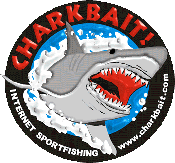"Tap"
The slight tap that I felt at the end of my line
signaled me to get ready. I lowered my rod tip and slowly reeled up all of the
slack, being very careful not to move the bait.
"Tap"
Again. I sat ready, keeping the bait
perfectly still. Then, my patience was rewarded with a strong, steady pull. I
reacted, not by setting the hook with a jerk, but by reeling fast, taking all of the
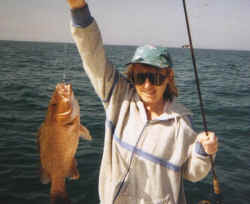 slack
and stretch out of the line, pulling the fish out away from the sharp rocks below.
Every angry shake of the fish's head was felt on the light 8 lb. test line as it struggled
to cut me off on the sharp rocks. But I was able to hold it, and moments later, a 3
lb. Sheephead, a common catch in Florida during the winter, came to the net.
slack
and stretch out of the line, pulling the fish out away from the sharp rocks below.
Every angry shake of the fish's head was felt on the light 8 lb. test line as it struggled
to cut me off on the sharp rocks. But I was able to hold it, and moments later, a 3
lb. Sheephead, a common catch in Florida during the winter, came to the net.
Although I'm catching Sheephead in Florida, this method will work anywhere you bottom
fish, especially when anchored over or near a structure, regardless of the species
targeted or the tackle employed.
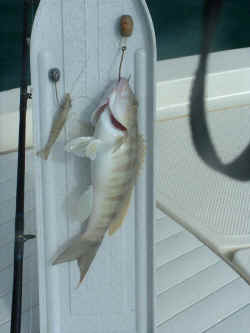 Let's look at the terminal tackle first.
When fishing light line, I prefer to double four feet of line, using either a
Bimini twist or a spider hitch. Then I use a double uni-knot or a black barrel
swivel to add on two feel of shock tippett. I use 2 ½ to 3 times the strength
of my running line for a leader. Example: when using 10 lb. spinning tackle, I
opt for a 25 to 30 lb. shock leader. Next I thread an egg sinker on the leader and
tie on a hook, allowing the sinker to rest right on the eye of the hook. Current,
wind, and water depth will determine the size sinker that is necessary. Use the
lightest weight that will reach and hold bottom. My first choice in a hook is a
Kahle style bait hook, though light circle hooks work well and are gaining in popularity.
Base your hook size on the size of the bait you are using and not the size of the
fish you are after. Too large a hook may look unnatural and scare off wary fish,
especially in clear water. Too small a hook and the bait may ball up and impede the
hook from piercing the fish's mouth. When using heavy conventional tackle, 40 lb. or
heavier, I skip the leader, tying the hook and sinker directly to the running line.
Let's look at the terminal tackle first.
When fishing light line, I prefer to double four feet of line, using either a
Bimini twist or a spider hitch. Then I use a double uni-knot or a black barrel
swivel to add on two feel of shock tippett. I use 2 ½ to 3 times the strength
of my running line for a leader. Example: when using 10 lb. spinning tackle, I
opt for a 25 to 30 lb. shock leader. Next I thread an egg sinker on the leader and
tie on a hook, allowing the sinker to rest right on the eye of the hook. Current,
wind, and water depth will determine the size sinker that is necessary. Use the
lightest weight that will reach and hold bottom. My first choice in a hook is a
Kahle style bait hook, though light circle hooks work well and are gaining in popularity.
Base your hook size on the size of the bait you are using and not the size of the
fish you are after. Too large a hook may look unnatural and scare off wary fish,
especially in clear water. Too small a hook and the bait may ball up and impede the
hook from piercing the fish's mouth. When using heavy conventional tackle, 40 lb. or
heavier, I skip the leader, tying the hook and sinker directly to the running line.
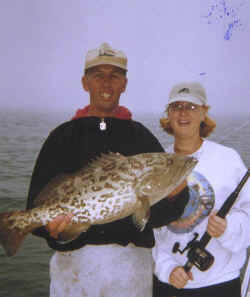 To employ this rig, you should be anchored
in deep water, either right over top of the structure, or just uptide from it. In
shallow water you will probably need to anchor away from the area you want to fish, and
cast in toward it. Either way, the technique is the same. First, bait the
hook, leaving the point of the hook exposed. Local baits vary, but shrimp, cut fish,
squid, and sea worms all work well. Your local bait shop should be able to tell you
what has been effective lately. Any small fish caught in the immediate area should
work well but check local regulations first. Small fish cut into steaks and hooked
just under the backbone work very well and stay on the hook longer than a fillet or a
strip.
To employ this rig, you should be anchored
in deep water, either right over top of the structure, or just uptide from it. In
shallow water you will probably need to anchor away from the area you want to fish, and
cast in toward it. Either way, the technique is the same. First, bait the
hook, leaving the point of the hook exposed. Local baits vary, but shrimp, cut fish,
squid, and sea worms all work well. Your local bait shop should be able to tell you
what has been effective lately. Any small fish caught in the immediate area should
work well but check local regulations first. Small fish cut into steaks and hooked
just under the backbone work very well and stay on the hook longer than a fillet or a
strip.
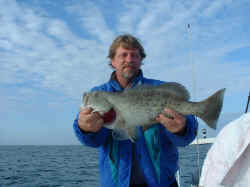 Next, lower or cast your bait out toward
the structure that you want to fish. Once it settles to the bottom, reel up the
slack and keep the bait very still, resting right on the bottom. When you feel the
first tap -- and this is very important -- don't move the bait at all. Resist the
urge to lift your rod tip to see if the fish is still there. You may feel several
taps, but remain motionless until you feel a steady pull. Then, don't set the hook
-- just reel fast!
Next, lower or cast your bait out toward
the structure that you want to fish. Once it settles to the bottom, reel up the
slack and keep the bait very still, resting right on the bottom. When you feel the
first tap -- and this is very important -- don't move the bait at all. Resist the
urge to lift your rod tip to see if the fish is still there. You may feel several
taps, but remain motionless until you feel a steady pull. Then, don't set the hook
-- just reel fast!
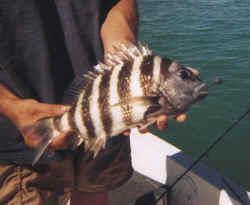 In deep water, where there is a lot of line
stretch, this is even more critical. By just reeling, all of the slack and stretch
is removed from the line and the fish can be pulled out away from the structure before it
feels the sting of the hook. I believe this technique is much more effective than
setting the hook with a sharp jerk, which gets the rod up high and out of position, making
it necessary to lower the rod tip to regain the slack. This brief moment is often
enough time for a good fish to swim into a hole or over a ledge and cut you off.
In deep water, where there is a lot of line
stretch, this is even more critical. By just reeling, all of the slack and stretch
is removed from the line and the fish can be pulled out away from the structure before it
feels the sting of the hook. I believe this technique is much more effective than
setting the hook with a sharp jerk, which gets the rod up high and out of position, making
it necessary to lower the rod tip to regain the slack. This brief moment is often
enough time for a good fish to swim into a hole or over a ledge and cut you off.
Once hooked, keep as much pressure as possible
on the fish, keeping it out of the bottom. If it does make a run, begin working it
back as soon as the run ends, when the fish is a little tired. Try this technique next
time you are out there bottom fishing. I think the number of fish you hook and land
will increase.
Just reel -- fast!
by Jim Klopfer
Adventure Charters
(941) 923-2605
*Look for Jim's reports in the
CharkByte's section of
CharkBait.




















































